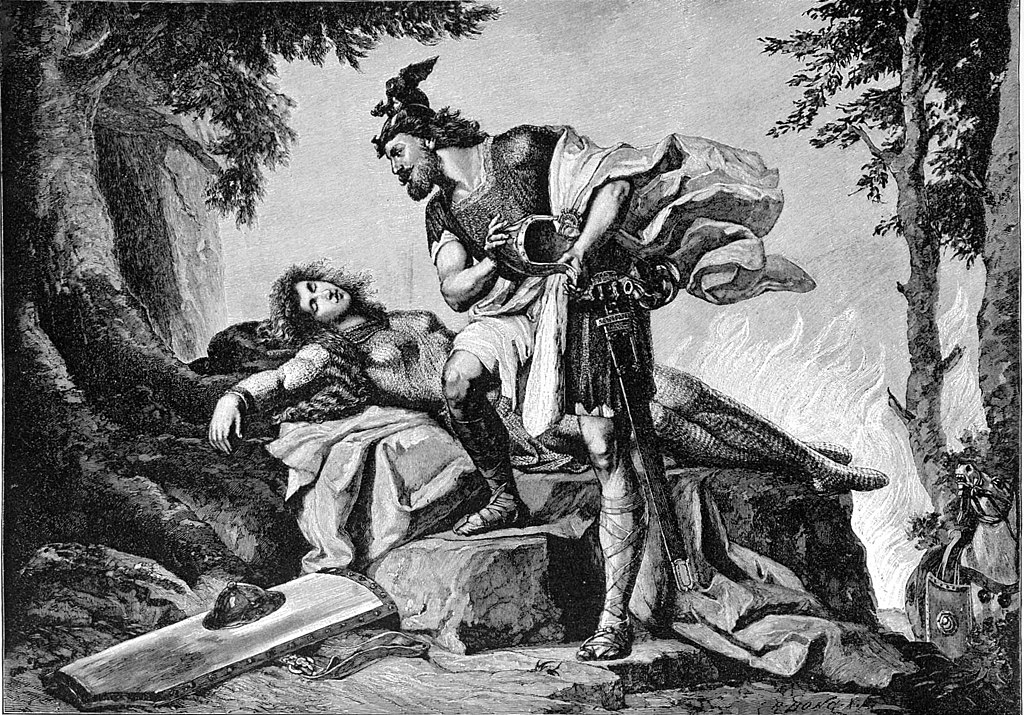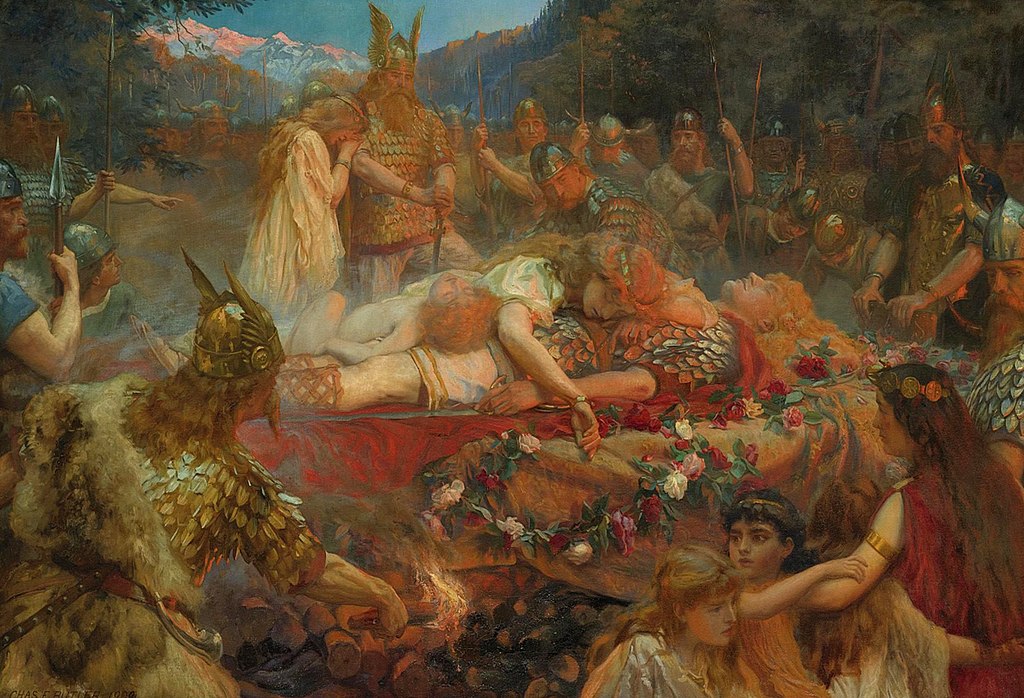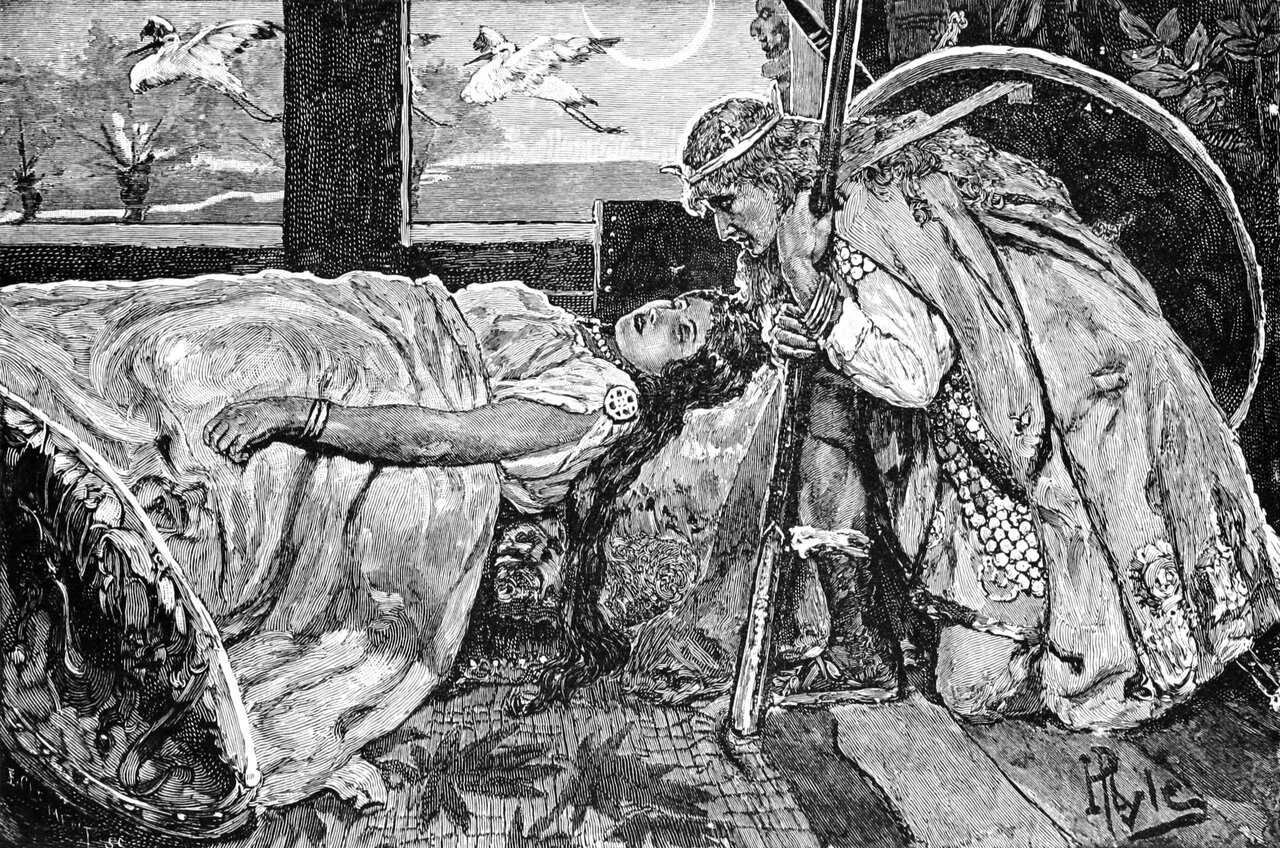Appearing in several examples of prose and poetry through the years, Brunhilde is a beautiful Amazon-like Valkyrie or perhaps a shieldmaiden. She appears in Old Norse mythology through the Poetic Edda and the Völsunga saga, in the Ring of the Nibelung, an ancient Germanic work of heroic literature, and in Richard Wagner’s late 19th-century operatic cycle “The Ring of the Nibelung.”
Who Is Brunhilde?
In Norse mythology, Brunhild or Brynhildr is a Valkyrie or female warrior.
The role of a Valkyrie was to spirit the “best of the slain” from the battlefield to Valhalla.
Brunhilde Etymology
The name has several subtle variations in its spelling. Google searches reveal the most hits if you use Brunhilda or Brunhilde, while Wikipedia favors Brunhild.
She was known as Brynhildr in Old Norse, Brünhilt in Middle High German, and Brünhild or Brünhilde in Modern German. Brynhild is another variation.
She may be related to Brunhilda, the Visigoth princess of Austrasia.
There are a few different meanings to the name in English. Some sources translate it as “ready for battle, “while others believe it to mean “dark” or “noble.”
The Story of Brunhilde in Norse Mythology
The Prose Edda and the Poetic Edda have separate versions of Brunhilde’s stories. The Prose Edda only attests her once and is the earliest known reference point for her in literature, dating back to around 1220.
Attestation in the Prose Edda
The Islandic politician, historian, and poet Snorri Sturluson wrote the Prose Edda, and his version of the most famous Brunhilde story is similar, although shorter, to the one found in the Poetic Edda:
Siegfried (or Sigurd) is returning from a tremendous adventure in which he killed Fáfnir, a dwarf that transformed into a dragon, and Fáfnir’s brother, Regin. Regin was a master smith who had made Siegfried a magical sword called Gram.
He had convinced Siegfried to kill Fáfnir so he could reclaim a share of a trove of golden treasure, including a ring called Andvaranaut that Loki had stolen from another dwarf named Andvare. Loki had undertaken this theft to pay back a debt he owed to Hreidmar, the father of Fáfnir and Regin.
Fáfnir decided he wanted the gold instead and killed his father, stealing the hoard and the all-powerful Ægir’s helmet. Using the helmet, he banished Regin, who was badgering him for a share of the gold.
After dismissing him, Fáfnir transformed into a dragon and took the gold to a heath called Gnita, where he lay guarding the treasure.
Slaying the Dragon
Siegfried, goaded on by Regin, went to kill Fáfnir, lying in a ditch on the heath, waiting for the dragon to walk across it on his way to drink. He could then use Gram to thrust upwards and attack the belly of the serpent. His plan worked; he was able to slay the dragon and collect the gold for Regin.
The treacherous Regin now plotted to kill Siegfried too. He pretended to be upset over how Siegfried had murdered his brother and had him roast Fáfnir’s heart to appease him. Feeling pangs of guilt after the killing, Siegfried agreed to cook the heart for Regin to eat.
After a while, he put his thumb into the heart to ensure it was ready. As he licked the blood off it, he found he was suddenly able to understand the language of birds.
He heard a pair of eagles nearby discussing how Regin planned to betray and kill Siegfried, so he used Gram to kill him in his sleep. While riding home with the gold, he found a maiden asleep in a house. She was wearing a helmet and a coat of mail, which he cut from her using Gram.

The Sorceress Grimhilde
She awoke and told him her name was Brunhilde, and she was a Valkyrie. He fell in love with her on the spot and promised to return and make her his wife. He left the castle and went to the court of his king Gjuke (or Gjuki) of Burgundy. Siegfried told the court about his adventures and how he intended to return to Brunhilde and marry her.
However, Gjuke’s wife, the sorceress Grimhilde, wished Siegfried to marry her daughter, Gudrun, instead and concocted a magic potion to make Siegfried forget all about Brunhilde. Siegfried married Gudrun, and instead, Grimhilde decided that Brunhilde would make a good wife for one of her sons, Gunnar.
As brothers-in-law, Siegfried had entered a blood-oath with Gunnar and another brother, Hogne. Consequently, he accompanied Gunnar to the home of Atle (or Atli), Brunhilde’s brother, for Gunnar to ask for Atle’s sister’s hand in marriage.
They found out Brunhilde had fallen into an everlasting sleep inside a house surrounded by a raging ring of fire called the Vafurloge. Odin created this curse after she had resolved a disagreement between two kings but had not supported the one that Odin favored.
Atli told the brothers that Brunhilde could only marry someone capable of riding through the flames.
Gote and Grane
Gunnar tried to ride his horse Gote through the fire, but the horse refused. Grane, Siegfried’s horse, was much braver but would only allow Siegfried to ride him. The only solution was for Siegfried to disguise himself as Gunnar by shapeshifting so Brunhilde would think it was Gunnar passing through the fire. He achieved this feat as he was still under the influence of the sorceress.
Siegfried, passing himself off as Gunnar, rode through the flames and wed Brunhilde that night, presenting her with the gold ring called Andvaranaut – Brunhilde gave him a gold ring in return. However, he did not consummate the marriage, placing Gram between them as they lay in the marriage bed for the next three nights.
Siegfried, still as Gunnar, left on the third morning and, once out of Brunhilde’s sight, shapeshifted back into himself. Siegfried gave the gold ring to Gudrun when he returned home.
Sometime later, Brunhilde, now living at the court with Gunnar, was washing her hair in the river next to Gudrun. Brunhilde commented that she did not wish Gudrun to use the same river water as her and told her to stand further downstream.
The Final Revelation
She said that Gudrun was not worthy as her own husband, Gunnar, was a braver man than Siegfried. Gudrun responded by telling Brunhilde how Siegfried had slain Fáfnir and Regin and brought back a hoard of gold. Brunhilde laughed and said that was nothing compared to the courage Gunnar had shown by riding through the Vafurloge.
At this, Gudrun revealed that it had been Siegfried, transformed into Gunnar, who had passed through the raging fire and showed Brunhilde the ring she had given “Gunnar” after their wedding. She also correctly identified the ring Andvaranaut Brunhilde wore on her finger, giving precise details about how Siegfried had come about it.
Enraged, Brunhilde convinced Gunnar and Hogne to kill Siegfried but being blood brothers to him, they could not. After persuading another brother, Guthorm, to commit the act, Siegfried killed him with Gram, cutting him in two. However, Guthorm had succeeded in surprising Siegfried as he slept, mortally wounding him. Siegfried’s child of only three also died in the attack, and some sources name Brunhilde as the assassin.
Still in love with Siegfried, she committed suicide by flinging herself onto his burning funeral pyre. Other accounts have her killing herself with Gram and being cremated on the same pyre as Siegfried.

Wagner’s “Ring” Cycle
Though the title of the four-opera cycle is Der Ring des Nibelungen, Richard Wagner used Norse Mythology as his inspiration rather than the Nibelung.
Brunhilde appears in the final three operas (Die Walküre, Siegfried, and Götterdämmerung) and plays a leading role in the downfall of Wotan, one of her parents.
The names of the characters are slightly different too. For instance, Siegfried is killed by Hagen, who is the son of Alberich and Gunther’s half-brother.

